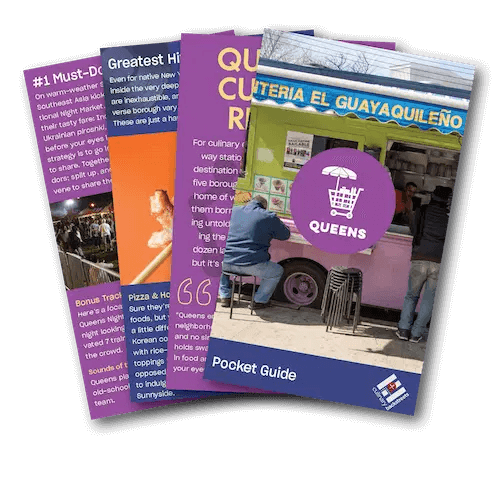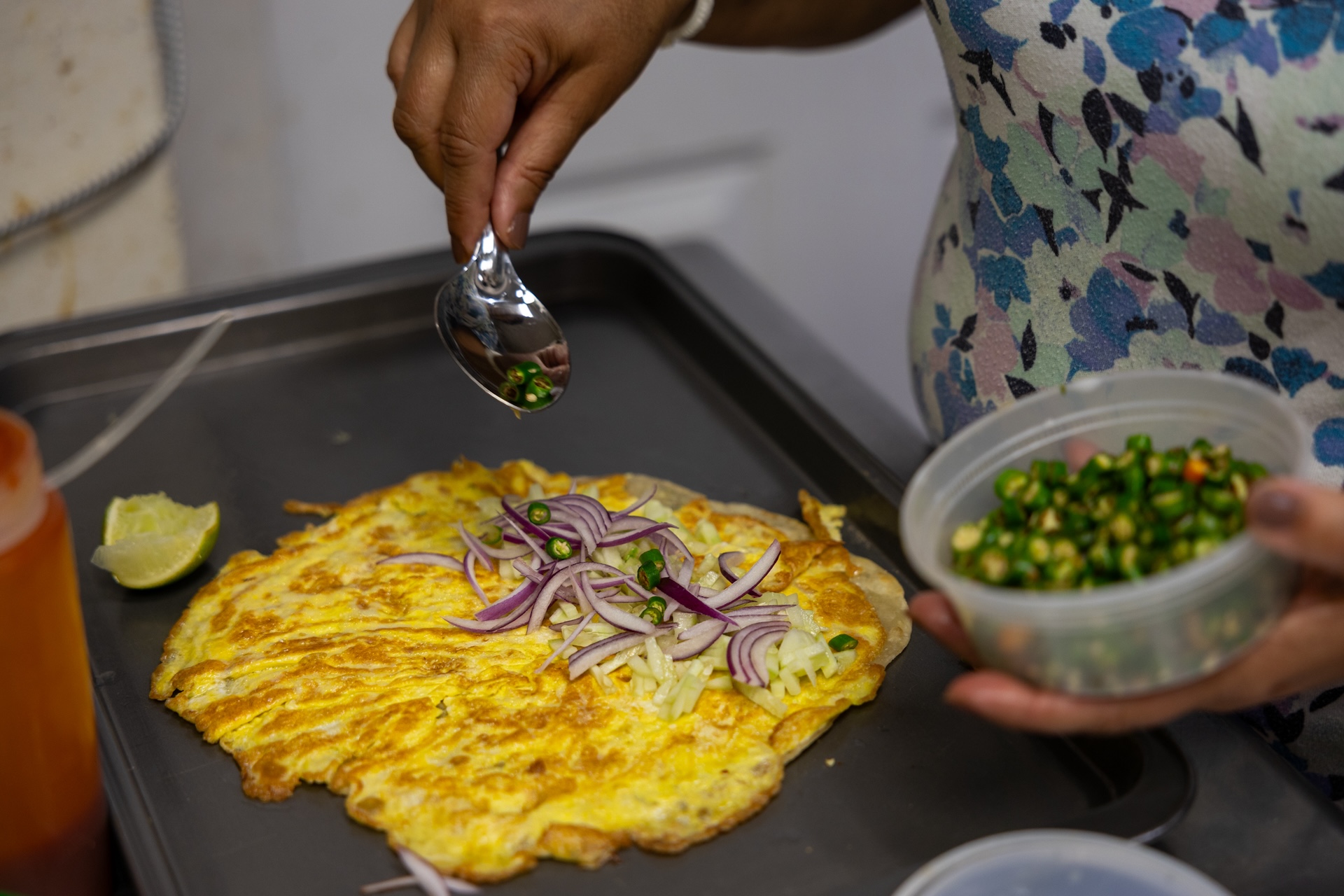We can't find the internet
Attempting to reconnect
Something went wrong!
Hang in there while we get back on track
Queens's culinary record
For culinary explorers, Queens is not merely a way station, it is a destination in itself. The largest in area of the five boroughs of New York City, Queens is the home of well over two million people, half of them born outside the United States, speaking untold hundreds of mother tongues. During the course of a day, you might hear a dozen languages without breaking a sweat. The gastronomic variety is perhaps even more astonishing. Queens embraces innumerable small neighborhoods within neighborhoods, and no single cuisine or family of cuisines holds sway in them all. The local favorites in food and drink, and the favorite ways to enjoy them, seem to change before your eyes every time you turn a corner.
Get the Full Story →
Get Your Free Queens Pocket Guide
Introducing our pocket-sized Queens guide — perfect for your next culinary adventure. Yours free when you sign up for our newsletter.
Get Your Free Queens Pocket Guide
Introducing our pocket-sized Queens guide — perfect for your next culinary adventure. Yours free when you sign up for our newsletter.
Visual Dispatches from the Frontlines of Local Eating
Queens Videos
Your Questions, Answered
Queens is one of the five boroughs of New York City. Queens alone is home to more than 2.4 million people, nearly half of whom were born abroad, and is more linguistically diverse than anywhere else in the world. The largest of the five boroughs by area, Queens borders Long Island Sound to the north, the Atlantic Ocean to the south, the Long Island suburbs to the east and the borough of Brooklyn to the west. The borough of Manhattan is just to the west, too, across a river but easy to reach by public transport or car.
Queens is very safe. It is particularly welcoming to visitors from many different backgrounds, since the borough is itself home to residents who first lived in many other countries and speak many different languages. On streets and in crowds, of course, do be mindful of wallets, purses, phones, cameras and other valuables.
Queens is famous for its unmatched variety of cuisines from all over the world, and so the “best” might well be one of the many cuisines that you’ve never tried. Naturally, you can find exceptional steamed dumplings and hand-pulled noodles from China, skewered meats and fried empanadas from all quarters of Latin America, and Italian ices in a rainbow of flavors. Just to take the letter “B,” enjoy cheese-sauced peppers in a Bhutanese billiard parlor; slurp-filled salteñas from a Bolivian sidewalk counter; dine on ilish, a fatty, oily Bangladeshi fish, to be eaten with the fingers; or try stuffed, griddled Burmese palatha at a night market. Queens (and the rest of the alphabet) awaits.
Most visitors to Queens venture to Manhattan for its landmarks, museums, shopping, theater and nightlife. But the wide-open spaces of Queens offer many outdoor attractions that cosmopolitan Manhattan can’t match. In Flushing Meadows Corona Park, the New York Mets baseball team play more than 80 games from spring till fall, and during two weeks in late summer the park also welcomes the U.S Open tennis championships. The tennis tournament’s former home, in Forest Hills, doesn’t sit idle; it hosts some two dozen pop and rock concerts during the warmer months.
Much of Queens was once farmland, and at the 47-acre Queens Country Farm Museum, in Floral Park, you can visit New York City’s last working farm, in continuous operation for more than three centuries. Of course, the unmatched variety of cuisines from all over the world is one of the greatest draws for visitors to Queens. Most street food vendors ply their trade year-round, as do restaurants, cafes, bakeries and markets. From May through October, street fairs and outdoor festivals are added attractions.
The best time to visit Queens is from late April through June, and from September through early November. July and August are generally sunny, too, but can be very hot and humid. In late summer – particularly September, the driest of these months – hotel rooms are hardest to come by.
The weather in Queens can be very changeable, so it’s wise to pack a travel umbrella and a light layer, such as a windbreaker, that you can add or remove easily. July and August are generally sunny, but the summer months can also be very hot and humid, with temperatures often near 90 F. Spring and fall – April through June, and September through November – are more pleasant, thanks to daily high temperatures in the 50s, 60s and 70s F, but pop-up rain showers are not uncommon, particularly in the spring. In winter, the temperature will rarely climb above 50 F, often accompanied by biting winds and occasionally by a wet, messy snowfall. If you visit during this season, waterproof boots are essential.
Prices in Queens are higher than in much of the United States, although not as high as in Manhattan. The average price of a 3-star hotel is about $180 per night. At many of our favorite restaurants, a three-course lunch or dinner for one person is about $40, although Queens offers many more-casual options – slices of pizza, a huge sandwich to share, all manner of street food – that allow you to eat your fill for far less. A cup of coffee is about $3, a draft beer is about $8.
Long Island City, at the western edge of the borough, is one of the best areas to stay in Queens. Via the elevated 7 train, it provides ready access to the culinary wonders in the Queens neighborhoods to the east – Sunnyside, Woodside, Jackson Heights, Elmhurst, Corona and Flushing – as well as a quick ride west into Manhattan. Many travelers to New York City prefer to stay in Manhattan for sightseeing and taking the train into Queens for a day of eating.
Queens is served by three major airports: John F. Kennedy International Airport (JFK); Newark Liberty International Airport (EWR), in the nearby state of New Jersey; and LaGuardia Airport (LGA). Most international travelers fly into JFK or Newark, where dedicated trains deliver them to public transport. From JFK, fixed-fare taxi rides are also available to anywhere in the city. LaGuardia, which serves travelers from the United States and Canada, is served by several bus routes as well as by taxis.
Parents will find plenty of food that their children will enjoy. Chinese dumplings and noodles, and Latin American kebabs and empanadas, quickly come to mind; so do Italian ices in a rainbow of flavors. Navigating a stroller through the narrow, crowded sidewalks of Flushing or Corona can be problematic, however. By contrast, the upper reaches of Astoria – several stops to the north from most Long Island City hotels on the elevated 7 train or a short ride by car – offer wider and less challenging sidewalks. These are home to many family-friendly Greek tavernas, cafes and restaurants. Gantry Plaza State Park, in southern Long Island City, offers a playground and a mist fountain; wide, paved walkways beside the East River; and spectacular views of Midtown Manhattan. Almost invariably, a convoy of food trucks will line up just outside the park, too.
About 85% of Queens residents are fully vaccinated; this rate is about 78% for New York City as a whole. Masks are not required in most indoor settings, but some individual establishments do set their own requirements, and so it’s good to keep a mask at the ready. All inbound international travelers over the age of 18 must be fully vaccinated. In addition, all inbound international travelers 2 years of age or older must show proof of a negative COVID-19 test result within the 24 hours prior to departure.
The unparalleled variety of culinary delights in Queens makes any head-to-head comparisons near-impossible, and so the “best” is hard to define. Even so, we can wholeheartedly recommend the “divine” food at Angel Indian Restaurant, the red-sauce fine dining at Park Side Restaurant and the soda-fountain “nostalgia, by the scoopful” at Eddie’s Sweet Shop.
As of June 25, 2021, domestic travelers to Queens, or to anywhere in New York State, are no longer required to submit traveler health forms or provide proof of vaccination. However, proof of vaccination is still required by some individual businesses.
Although Queens is surrounded on several sides by water, generally the waterfront offers little more than a view. The exception is Rockaway Beach, which boasts a five-and-a-half-mile-long boardwalk and an even longer beach open all summer for sunbathing, swimming and – if you’re game to rent a wetsuit and board – surfing. From much of Queens you can reach the beach in less than an hour by car, or an hour-and-a-half by public transport. Pass through the Jamaica Bay Wildlife Refuge on your way, a sprawling sanctuary for hundreds of bird species on the southern outskirts of the borough, offers guided presentations, hikes and family programs year-round.















































